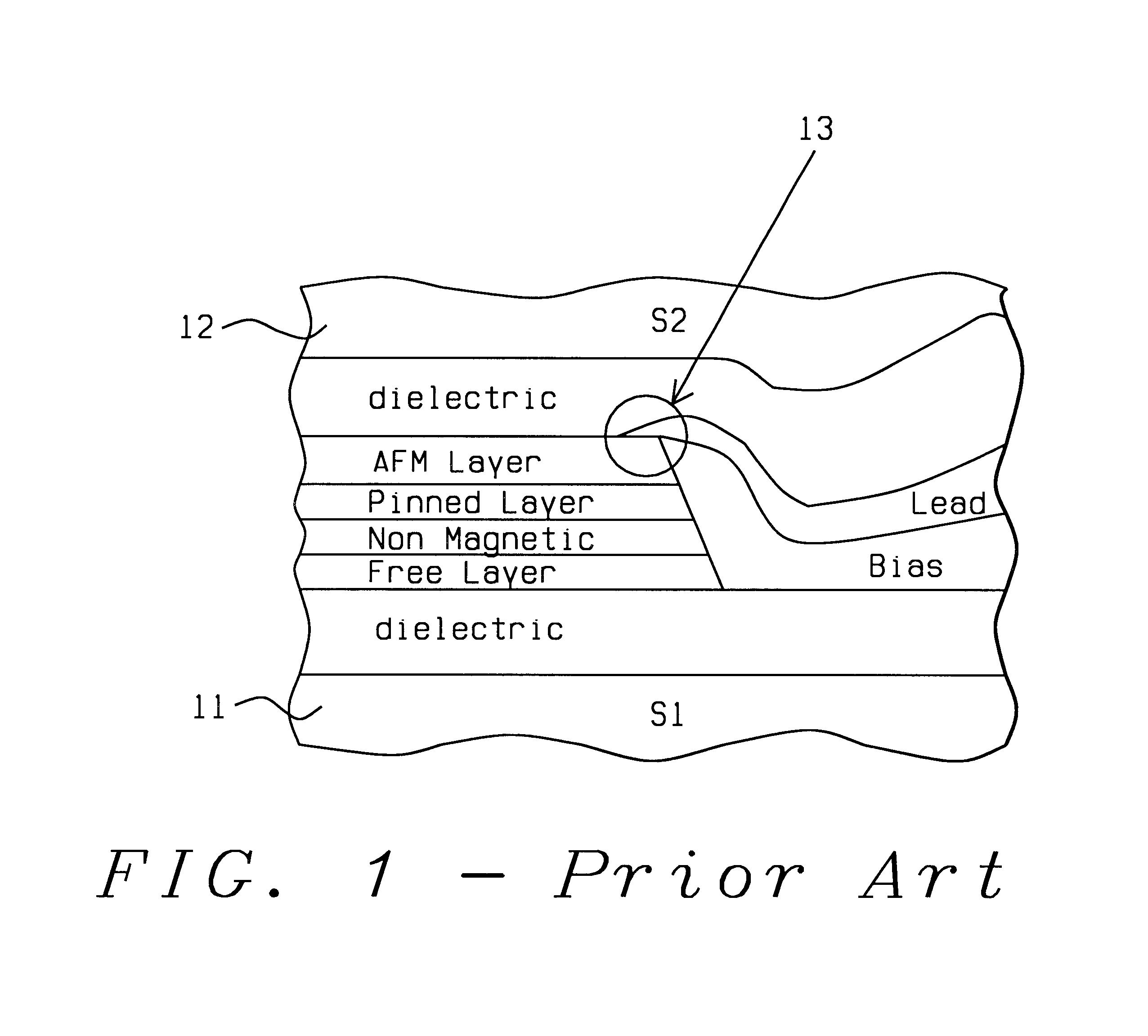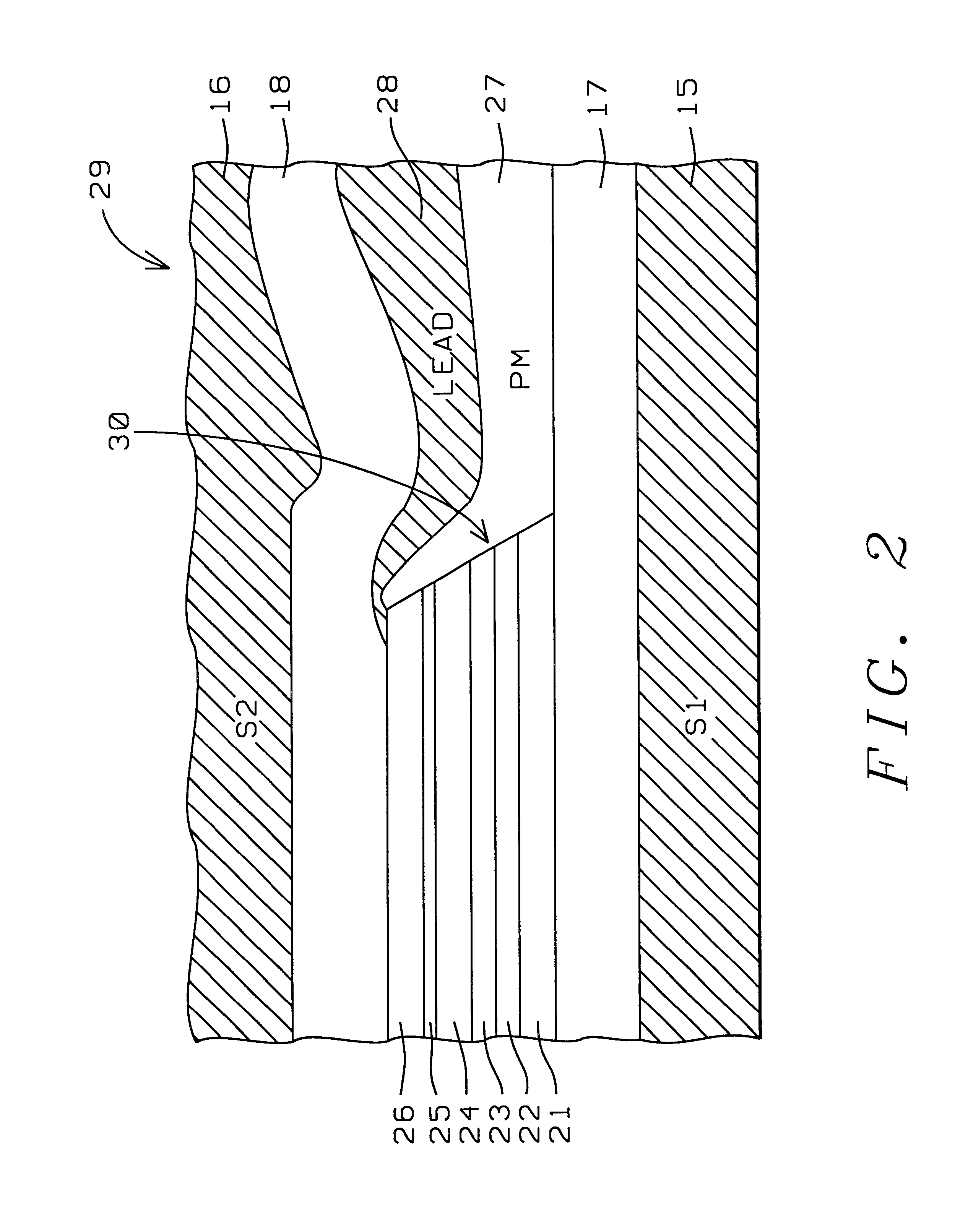Process to manufacture a top spin valve
a manufacturing process and spin valve technology, applied in the field of magnetic recording, can solve the problems of significant increase in the resistance of the entire structure, and the shield-to-shield separation of the spin valve head cannot be below about 800 , achieve the effect of narrowing the feedback pulse width and large shield-to-shield spacing
- Summary
- Abstract
- Description
- Claims
- Application Information
AI Technical Summary
Benefits of technology
Problems solved by technology
Method used
Image
Examples
first embodiment
[0025]This process is for manufacturing a top spin valve structure. It begins with the provision the first (lower) of the two primary magnetic shields. This can be seen as layer 15 in FIG. 2 on which dielectric layer 17 is deposited, followed by the deposition of free layer 21. This is followed by the deposition of non-magnetic layer 22 onto which is deposited pinned layer 23. Next, onto pinned layer 23 there is deposited anti-ferromagnetic layer 24 for use as a pinning layer. This completes formation of the spin valve itself.
[0026]Now follows a key feature of the invention. On anti-ferromagnetic layer 24, decoupling layer 25 is deposited, followed by the deposition of thin film shield 26. The purpose of the decoupling layer is to avoid any exchange coupling of the thin film shield by layer 24. The thin film shield is a layer of ferromagnetic material having a permeability greater than about 500. It needs to have as high an electrical resistivity as possible within other constraints...
second embodiment
[0029]This process is also for manufacturing a top spin valve structure. Referring now to FIG. 3, this embodiment begins with the provision of the first (lower) of the two primary magnetic shields 15 on which dielectric layer 17 is deposited. Now follows a key feature of the invention, namely the deposition of thin film shield 36. The thin film shield is a layer of high permeability (greater than about 500) ferromagnetic material. It needs to have as high an electrical resistivity as possible within other constraints of the structure. It is required to be at least 5 times more resistive than the free layer. Since the latter is about 25 micro-ohm-cm, a value greater than about 125 micro-ohm-cm is to be preferred. The thickness of the thin film shield should be such that the moment-thickness product (of the thin film shield) is 2-5 times that of the free layer. The presence of this thin film shield allows relatively thicker dielectric layers to be used, thereby reducing or eliminating...
third embodiment
[0033]This process is also for manufacturing a top spin valve structure. We refer now to FIG. 4 which begins with the provision of the first (lower) of the two primary magnetic shields 15 onto which is deposited dielectric layer 17. Then, on a selected area at the surface of layer 17, a layer of conductive material 47, suitable for use as a connecting lead to the structure, is deposited. Then, on layer 47 only, layer 48 of a ferromagnetic material suitable for use as an exchange magnet is deposited. This will serve to provide the needed longitudinal bias for the structure, as discussed above.
[0034]Then, free layer 21 is deposited over the full surface followed by the deposition of non-magnetic layer 22 onto which is deposited pinned layer 23. Next, onto pinned layer 23 there is deposited anti-ferromagnetic layer 24 for use as a pinning layer.
[0035]Now follows a key feature of the invention. On anti-ferromagnetic layer 24, decoupling layer 25 is deposited, followed by the deposition ...
PUM
| Property | Measurement | Unit |
|---|---|---|
| angle | aaaaa | aaaaa |
| magnetic | aaaaa | aaaaa |
| non-magnetic | aaaaa | aaaaa |
Abstract
Description
Claims
Application Information
 Login to View More
Login to View More - R&D
- Intellectual Property
- Life Sciences
- Materials
- Tech Scout
- Unparalleled Data Quality
- Higher Quality Content
- 60% Fewer Hallucinations
Browse by: Latest US Patents, China's latest patents, Technical Efficacy Thesaurus, Application Domain, Technology Topic, Popular Technical Reports.
© 2025 PatSnap. All rights reserved.Legal|Privacy policy|Modern Slavery Act Transparency Statement|Sitemap|About US| Contact US: help@patsnap.com



